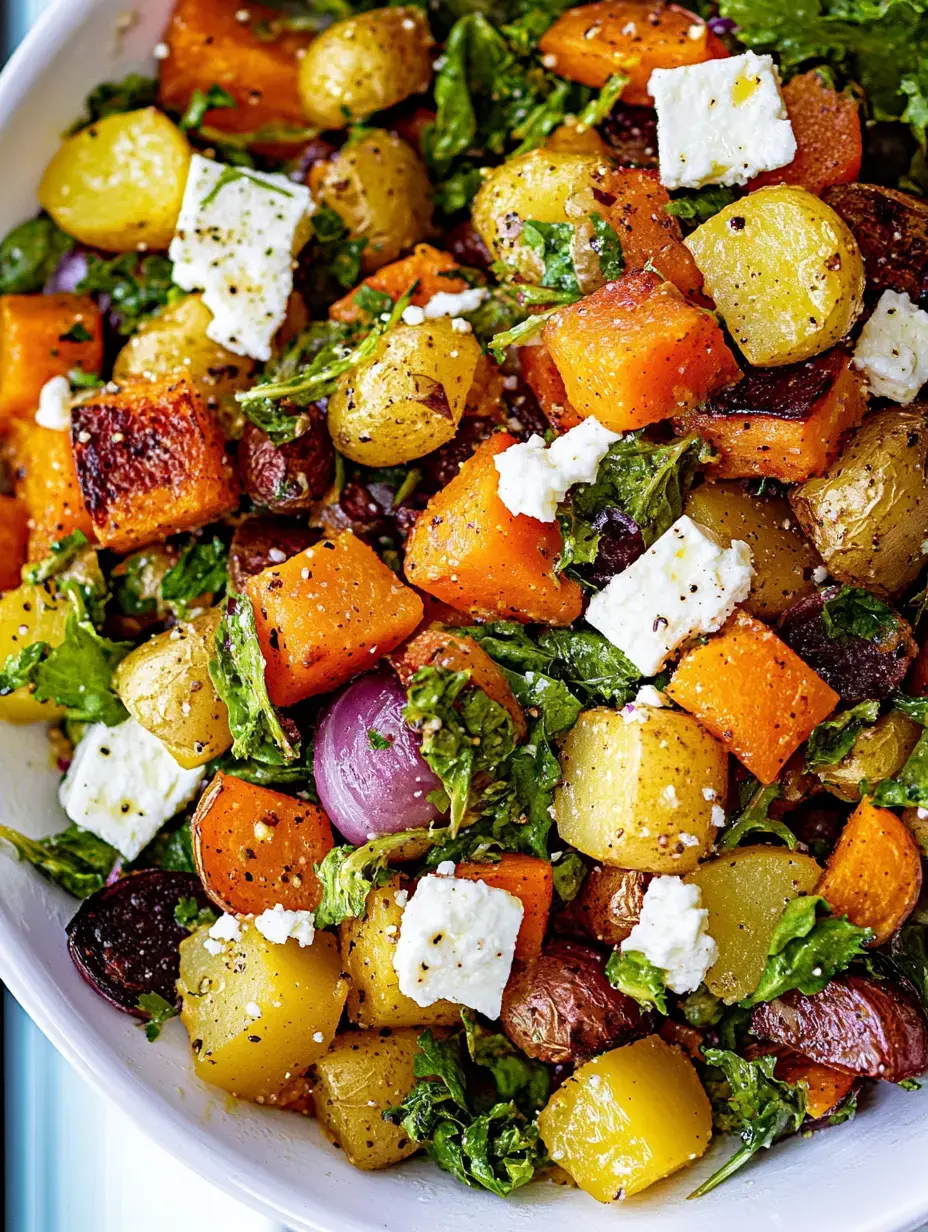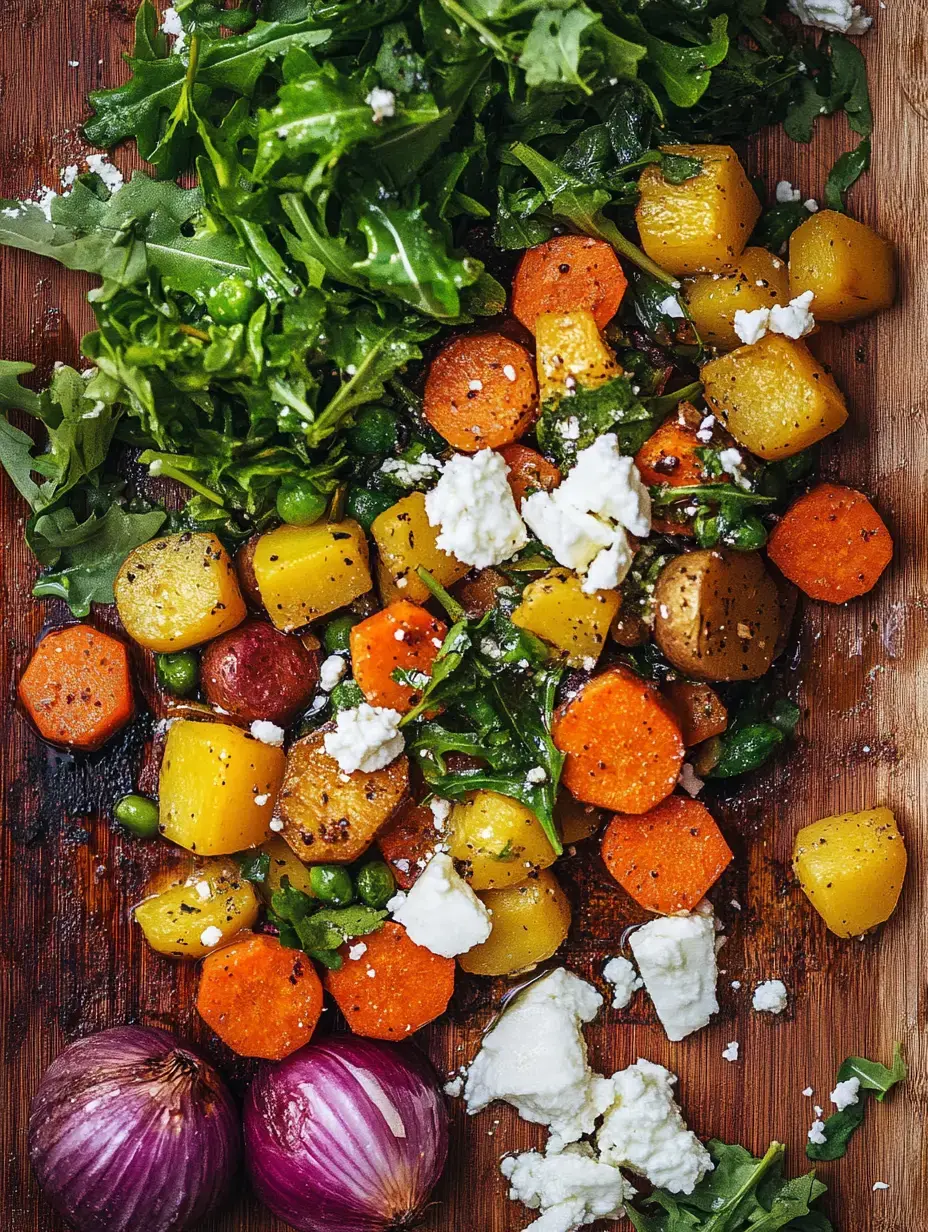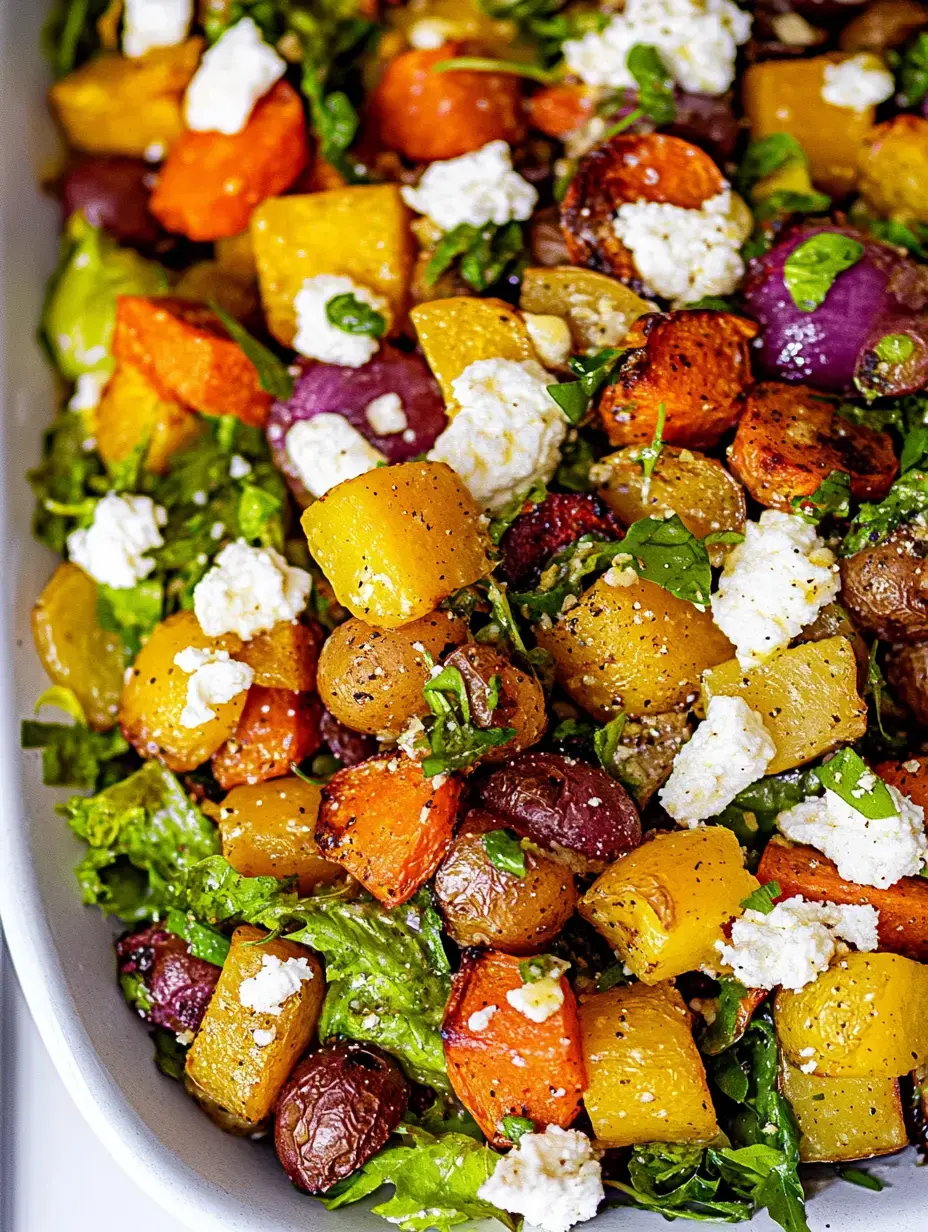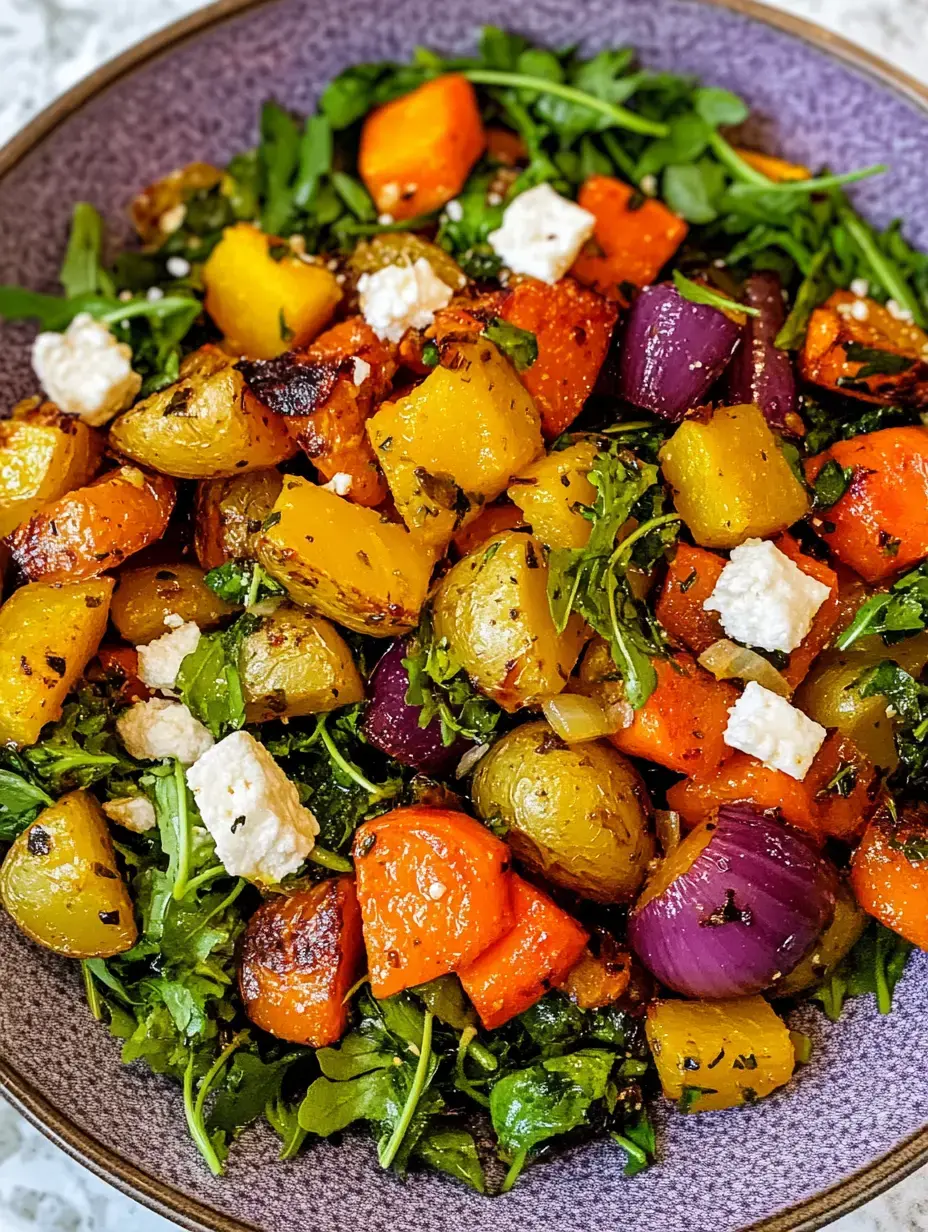 Pin it
Pin it
Let me share my absolute favorite winter recipe that completely transformed how my family thinks about salads. After years of hosting dinner parties and family gatherings, I've discovered that warm roasted vegetables are the secret to creating salads that people actually crave and request. This isn't your typical bowl of cold greens - this is a hearty celebration of winter produce that's both nourishing and deeply satisfying. Every time I serve this at our gatherings, my guests are amazed at how a salad can taste this incredible. The magic happens when those vegetables caramelize in the oven, creating sweet crispy edges and tender middles that make every bite absolutely delicious. The combination of textures and temperatures, from the warm roasted vegetables to the fresh crisp greens, creates an experience that's completely different from any salad you've had before. Even my brother-in-law, who usually pushes salads aside, now asks for seconds whenever this appears on our table. It's become such a staple in our winter menu that friends and family actually look forward to salad night - something I never thought possible during the cold months.
The Perfect Balance of Comfort and Health
Winter cooking in my kitchen is all about finding that sweet spot between comfort and nourishment. This salad was born during one particularly cold January when I was craving something warm and filling but didn't want the heaviness of traditional winter dishes. The combination of hot roasted vegetables straight from the oven landing on fresh crisp greens creates this wonderful temperature contrast that makes every bite exciting and satisfying. The warmth of the vegetables gently wilts the greens just slightly, creating this perfect middle ground where comfort food meets fresh and healthy. I love watching people's expressions when they take their first bite - there's always this moment of surprise when they realize a salad can be this satisfying and warming. The best part is how you feel afterward - energized and nourished rather than weighed down. It's become our go-to meal for those nights when we want something that feels indulgent but keeps us feeling light and vibrant.
Essential Winter Vegetables
The beauty of this salad lies in the careful selection of winter vegetables. I start with red onions, which transform into sweet, caramelized gems in the oven. Then comes butternut squash for its velvety texture and natural sweetness, along with hearty potatoes that bring substance to the dish. My secret weapon is using a mix of both orange and purple carrots, plus parsnips that develop an incredible sweetness when roasted. Each vegetable gets cut into similar-sized pieces to ensure even cooking, then generously coated with olive oil and seasonings. I've learned through countless preparations that giving vegetables plenty of space on the baking sheet is crucial - overcrowding leads to steaming instead of that beautiful caramelization we're after. Sometimes I'll toss in whole garlic cloves that roast to sweet, spreadable perfection, adding another layer of depth to the final dish. The key is treating each vegetable with respect, understanding how it will transform in the heat of the oven.
The Art of Perfect Roasting
Through years of making this salad, I've mastered the art of roasting vegetables to perfection. It starts with preheating the oven to exactly 400°F - this temperature creates the perfect environment for caramelization without burning. I always preheat my baking sheets too, a game-changing technique that jumpstarts the browning process the moment vegetables hit the pan. Spacing is crucial - each piece needs room to breathe and develop those irresistible crispy edges. I've discovered that leaving the vegetables undisturbed for the first 20 minutes is essential for developing that golden crust we're after. When seasoning, I go beyond just salt and pepper, often adding fresh thyme sprigs, rosemary, or sage leaves to infuse everything with aromatic winter flavors. The real test comes about 30 minutes in, when the kitchen fills with the most amazing aroma of caramelizing vegetables - that's when I know magic is happening in the oven.
 Pin it
Pin it
Creating the Perfect Base
The foundation of this salad is just as important as those gorgeous roasted vegetables. I've experimented endlessly with different combinations of greens to find the perfect mix that can stand up to warm toppings without wilting completely. My winning combination includes peppery arugula for bite, tender baby spinach for nutrients, and a bit of crisp romaine for texture. During winter farmers markets, I often incorporate sturdy greens like thinly sliced kale or rainbow chard, which add both nutrition and visual interest. The key is creating a base that's substantial enough to hold up to those warm vegetables while still maintaining its own character and crunch. I make sure all greens are completely dry before assembling - any water will cause them to wilt prematurely and dilute the wonderful flavors of our roasted vegetables and dressing. This attention to detail makes all the difference in the final presentation and eating experience.
A Dressing to Remember
The dressing for this salad has evolved over countless iterations to become something truly special. It starts with the highest quality olive oil I can find, partnered with aged balsamic vinegar that's naturally thick and sweet. To this base, I add a generous handful of fresh herbs - whatever looks best at the market, though in winter I particularly love the combination of rosemary, thyme, and sage. The real secret comes from incorporating some of the roasted garlic cloves from our vegetable pan, mashing them into a paste that adds incredible depth and complexity. A touch of Dijon mustard helps emulsify everything while adding a subtle tang that balances perfectly with our sweet roasted vegetables. I've found that making the dressing while the vegetables roast allows the flavors to meld beautifully, and the warmth of the vegetables when they hit the dressing releases an amazing aroma that fills the whole kitchen.
Adding Protein and Texture
While this salad shines on its own, I love offering various protein options to make it a complete meal. One of my favorite additions is crispy chickpeas roasted with cumin, smoked paprika, and a touch of cayenne - they add protein and a wonderful crunch that complements the tender vegetables perfectly. For non-vegetarian versions, I'll often add grilled chicken marinated in herbs and garlic, or pan-seared salmon with crispy skin. Sometimes I'll scatter toasted pepitas or marcona almonds across the top, adding another layer of texture and nutritional value. The key is choosing additions that enhance rather than overwhelm the roasted vegetables. I keep containers of these toppings prepared so family members can customize their bowls according to their preferences and dietary needs. This adaptability has made the salad a crowd-pleaser at both casual family dinners and larger gatherings.
Seasonal Adaptations
One of the most beautiful aspects of this salad is how it evolves throughout the winter season. Early winter brings gorgeous brussels sprouts and cauliflower, which develop incredible nutty flavors when roasted. Mid-winter is perfect for exploring the full range of root vegetables - think watermelon radishes, golden beets, and rutabagas, each bringing their own character to the mix. As we edge toward spring, early crops like tender baby carrots and asparagus tips can be incorporated, bridging the seasons beautifully. I've learned to let the market guide my choices rather than sticking rigidly to a recipe, and some of our favorite combinations have come from experimenting with whatever looked particularly fresh that day. This flexibility has turned the salad into a living dish that reflects the subtle changes in seasons while maintaining its comforting winter character.
Make-Ahead Strategies
Years of entertaining have taught me invaluable lessons about preparing this salad efficiently without sacrificing quality. The vegetables can be roasted a day ahead and quickly reheated in a hot oven just before serving - while they might lose a tiny bit of their initial crispness, the convenience often outweighs this small compromise. The dressing can be prepared up to three days in advance, stored in a jar in the refrigerator, though it should be brought to room temperature before using. I've found that prepping the greens properly - washing, thoroughly drying, and storing them wrapped in slightly damp paper towels in a sealed container - keeps them fresh and crisp for several days. When it's time to serve, I love bringing the whole salad to the table composed but undressed, creating a beautiful presentation that lets everyone appreciate the colors and textures before everything is tossed together.
 Pin it
Pin it
Perfect Pairings
Over time, I've discovered wonderful combinations that make this salad part of an unforgettable meal. A loaf of crusty sourdough bread, warmed in the oven and served alongside, is perfect for soaking up the flavorful dressing and any juices from the roasted vegetables. When it comes to wine, I lean toward light to medium-bodied reds like Pinot Noir or fuller-bodied whites like oaked Chardonnay - both complement the caramelized vegetables beautifully while standing up to the robust flavors. For special occasions, I might start the meal with a simple butternut squash soup and end with poached pears in spiced wine, creating a cohesive winter menu that celebrates seasonal ingredients. The key is keeping accompanying dishes simple enough to let the salad shine while still creating a satisfying and memorable dining experience.
Presentation Matters
The visual appeal of this salad adds immensely to its enjoyment, and I've developed some favorite presentation techniques over the years. I use my largest, shallow serving bowl which provides ample room to arrange everything beautifully without crowding. Starting with a generous bed of mixed greens, I arrange the roasted vegetables in clusters of color, creating a patchwork effect that showcases each component. Rather than tossing everything together immediately, I let the warm vegetables rest atop the greens, creating those lovely temperature contrasts and allowing guests to appreciate the care that went into preparing each element. A drizzle of the herb-flecked dressing catches in the nooks and crannies of the vegetables, and final touches of crumbled cheese, fresh herbs, or toasted nuts add that perfect finishing touch.
Gathering Around the Table
What makes this salad truly special is how it brings people together. There's something about a beautifully presented dish that starts conversations - guests want to know about the different vegetables, how they were prepared, what makes the dressing so special. I love watching people's expressions when they first taste it, especially those who claim they don't like salads. The colors are so vibrant, the aromas of roasted vegetables and fresh herbs so inviting, that it immediately draws people in. This dish has become a catalyst for longer, more enjoyable meals where people linger at the table, helping themselves to seconds while sharing stories and creating memories. It's these moments of connection over good food that make cooking such a joy.
Creative Leftovers
One of my favorite aspects of this salad is how beautifully it transforms into other dishes the next day. The roasted vegetables take on new life when gently reheated and served over quinoa or folded into an omelet. I often make extra vegetables specifically for this purpose, knowing they'll be just as delicious in different preparations throughout the week. Leftover dressed greens, while no longer crisp, can be wilted into a warm grain bowl or added to a soup in the last few minutes of cooking. Even the dressing finds new uses, drizzled over grilled bread or tossed with freshly cooked pasta. This versatility has taught me to think of leftovers not as mere remains but as ingredients for creative new dishes that carry forward all those wonderful flavors.
 Pin it
Pin it
Building Kitchen Confidence
Making this salad has become more than just preparing a meal - it's about building confidence in the kitchen. I love sharing this recipe because it teaches so many fundamental cooking skills, from properly roasting vegetables to making a balanced dressing and creating beautiful presentations. The forgiving nature of roasted vegetables makes it perfect for experimenting and developing your own style. Over the years, I've watched friends and family members start with this basic recipe then begin creating their own variations, adding their personal touches and preferences. There's something incredibly rewarding about seeing someone discover their own cooking intuition through a recipe that's both approachable and impressive.
Frequently Asked Questions
- → Can I use different vegetables?
- Yes, use any root vegetables or even cauliflower and broccoli. It's perfect for using up vegetables that need cooking.
- → How can I make this vegan?
- Skip the feta cheese or use a dairy-free alternative. Add chickpeas for extra protein.
- → Can I prep this ahead?
- Roast vegetables ahead and reheat slightly before serving. Assemble with fresh greens just before eating.
- → How can I add more protein?
- Add chickpeas, grilled chicken, or top with mixed seeds. The salad is very adaptable to additions.
